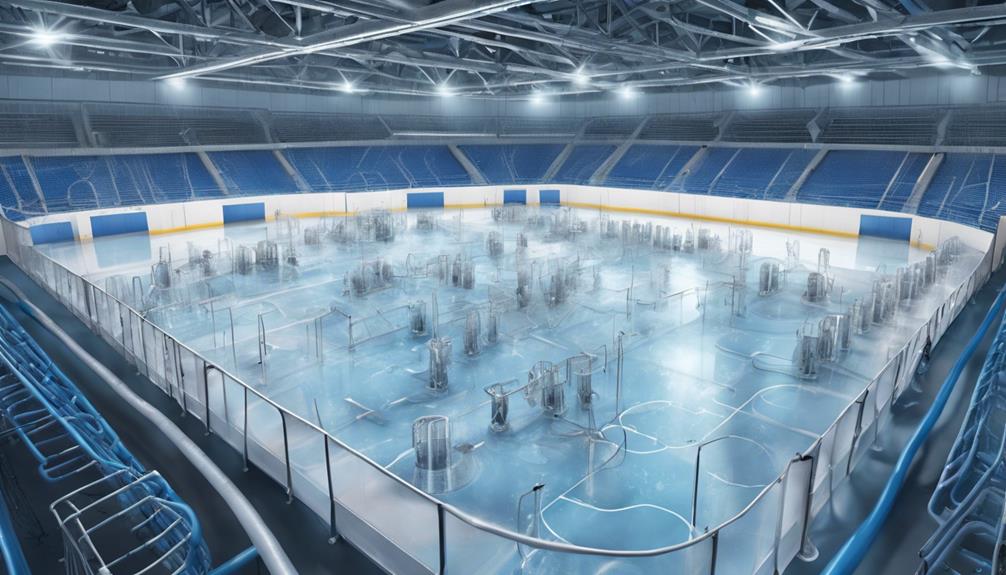The concept of how a hockey ice rink manages to remain frozen amidst the flurry of activity and heat-generating players is a fascinating one. The intricate system that keeps the ice at the optimal temperature involves a delicate balance of several components working in unison. From the sophisticated refrigeration units to the precise insulation techniques, each element plays a crucial role in maintaining the icy surface.
However, there is a pivotal aspect that often goes unnoticed but significantly impacts the rink's quality and durability.
The Basics of Ice Rink Refrigeration
Ice rink refrigeration systems are crucial for maintaining the optimal ice surface conditions required for hockey games and practices. Achieving the correct ice thickness is fundamental for player safety and game performance.
Cooling techniques play a vital role in this process, with direct refrigeration systems being the most common method used in ice rinks. These systems involve running a refrigerant through a network of pipes underneath the ice surface. The cold refrigerant absorbs heat from the ice, ensuring it remains solid and smooth.
Additionally, some rinks utilize secondary refrigerants to transfer the cooling effect to the primary refrigeration system, enhancing efficiency. Understanding these cooling techniques is essential for maintaining the ideal ice conditions for hockey gameplay.
Importance of Temperature Control Systems
Maintaining precise temperature control systems is pivotal in ensuring the efficiency and effectiveness of ice rink refrigeration for optimal hockey gameplay conditions.
- Energy Efficiency: Temperature control systems help regulate energy consumption, optimizing the cooling process while minimizing waste.
- Climate Control: By accurately managing temperatures, these systems ensure a consistent climate within the rink, regardless of external weather conditions.
- Precision Monitoring: Temperature control systems provide real-time data on the ice surface and surrounding environment, allowing for immediate adjustments to maintain ideal playing conditions.
- Efficient Operation: These systems work seamlessly with refrigeration units, ensuring that the ice remains at the perfect temperature for players' performance and safety.
Role of Insulation in Ice Maintenance
In the realm of ice rink maintenance, the role of insulation is paramount in sustaining the optimal conditions required for top-tier hockey gameplay. Insulation efficiency plays a crucial part in conserving energy consumption by minimizing heat transfer between the ice surface and the surrounding environment.
High-quality insulation materials, such as foam boards or reflective barriers, are strategically installed beneath the ice surface and around the rink perimeter to reduce energy loss and maintain stable temperatures. Proper insulation not only helps in keeping the ice frozen but also contributes to cost savings by decreasing the amount of energy needed to refrigerate the rink.
Understanding Ice Resurfacing Process
Utilizing specialized equipment and meticulous precision, the ice resurfacing process is a critical procedure in maintaining the pristine condition of the hockey rink surface. To better understand this process, consider the following steps:
- Scraping: A sharp blade shaves off the top layer of the ice, removing imperfections and creating a smooth surface.
- Washing: Water is sprayed onto the ice to remove debris and contaminants, ensuring a clean surface for the next step.
- Flooding: A thin layer of hot water is applied, filling in any remaining gaps and creating a seamless ice surface.
- Blade Smoothing: The final step involves a fresh layer of water that freezes quickly, creating a mirror-like finish for optimal playability.
Efficiency in ice resurfacing techniques is essential to minimize energy consumption and maintain high-quality ice conditions.
Impact of Humidity on Ice Quality
Humidity levels play a significant role in influencing the quality and integrity of the ice surface in a hockey rink. Proper humidity control is crucial as high humidity can lead to poor ice formation, resulting in a softer and less durable surface.
When the air is too humid, the water molecules in the air can interfere with the freezing process, causing imperfections like air bubbles and rough patches on the ice. To maintain optimal ice quality, rink operators must monitor and regulate humidity levels within the facility.
Maintenance Tips for Ice Rink Longevity
To maximize the longevity of an ice rink, implementing a proactive maintenance regimen is essential to uphold the quality and performance of the skating surface. Here are four crucial maintenance tips for ensuring the durability and functionality of an ice rink:
- Regularly Measure Ice Thickness: Monitoring the ice thickness ensures that it remains at optimal levels for safe skating and helps prevent premature melting.
- Scheduled Ice Painting: Conducting regular ice painting not only enhances the appearance of the rink but also helps maintain ice quality by sealing the surface and preventing cracks.
- Ice Resurfacing: Performing routine ice resurfacing procedures smoothens out imperfections, ensuring a consistent and safe skating experience.
- Temperature Control: Maintaining proper temperature levels within the rink area is vital to prevent fluctuations that could impact the quality and integrity of the ice surface.
Frequently Asked Questions
How Often Do Ice Rinks Need to Be Resurfaced During a Typical Game or Practice Session?
During a typical game or practice session, ice rinks need to be resurfaced intermittently to maintain optimal playing conditions for skaters. This process, known as "Zamboni-ing," involves equipment maintenance to ensure smooth and safe ice.
What Measures Are Taken to Prevent the Ice From Melting During Warmer Weather or in Non-Climate Controlled Arenas?
To prevent ice from melting in warmer weather or non-climate controlled arenas, insulation methods such as thermal barriers are employed. Backup generators ensure continuous power for cooling techniques like refrigeration systems. Regular maintenance procedures are conducted to monitor and optimize ice conditions.
Are There Any Environmental Concerns or Regulations Related to the Refrigerants Used in Ice Rink Cooling Systems?
Environmental regulations play a vital role in ensuring refrigerant safety in ice rink cooling systems. Compliance with guidelines such as proper handling, leak detection, and responsible disposal is crucial to minimize environmental impact and protect public health.
How Do Ice Rinks Manage to Keep the Ice Level and Smooth Despite the Constant Movement of Players and Equipment on the Surface?
Maintaining ice quality on a hockey rink despite player activity involves meticulous ice maintenance routines. Temperatures are closely regulated to prevent melting and maintain a smooth surface. This requires continuous monitoring and resurfacing to ensure optimal playing conditions.
How Do Ice Rinks Ensure the Safety of Players and Spectators in Case of a Power Outage or Equipment Failure Affecting the Refrigeration System?
Ice rinks prioritize safety with robust emergency protocols. In the event of power outages or equipment failures, backup generators kick in to maintain essential systems. These measures ensure ongoing safety for players and spectators.









